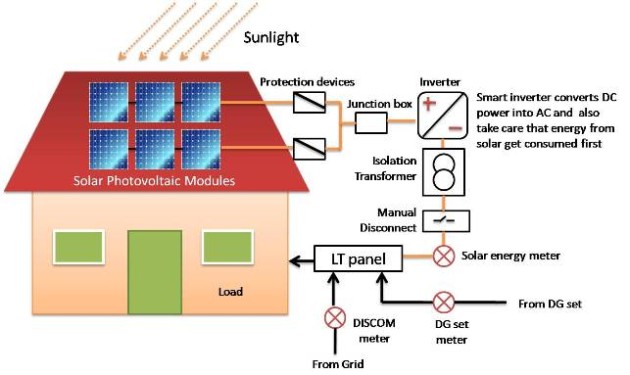Points to be considered before opting for rooftop solar power plant
As discussed in the first part of this article, rooftop solar systems have very less critical components. It is majorly made up of solar PV panels, supporting structures, inverter, transformer, metering units, switches and cables.
A typical single line diagram of the off-grid rooftop solar system is given below;

You can design and set up the entire system by yourself or can hire a professional vendor /turnkey solution provider for the same. There are multiple agencies working in this field. Some of these agencies have their own solar PV module manufacturing facilities. However, many of them buy different components of the system from various manufacturers and assemble it as per your requirements and possible configuration. Following are the key important points explain this process in detail;
Vendor selection
Since the solar power sector is a new entrant in the market, there are very few vendors available however they are growing rapidly. Therefore, it is very important to select the right vendor for you. The capabilities of vendor in your region can be assessed using parameters such as number of previous projects commissioned by the vendor, number of satisfied customers, financial position, number of technicians available in your city, type and technical credibility of critical components that vendor has proposed to you as well as to other customers, etc. Life of solar power project is about 25 years. Hence, it is always importance to use only quality material. Other factors such as details of Operations & Maintenance contract need to be carefully checked. You can always take advice of third party verifiers to maintain required standards.
Feasibility assessment
Solar photovoltaic (PV) technology turns light into the electricity. This is a very simple technology and requires very less efforts to install the entire system on your rooftop. However, assessing the feasibility of solar power plant is equally important. Feasibility of a solar power plant is dependent on a number of factors that affect the performance of the plant.
- Site Analysis: Site analysis includes structural analysis of roof, inclination, shadow analysis and accessibility
- Local weather conditions: Output from the solar power plant depends on the solar irradiation, temperature, air velocity
- Electricity consumption pattern: For non battery backed solar power plants, the capacity of the plant has to be designed to match base load of your building/facility to ensure all the power generated is consumed. This is because excess generation cannot be stored and hence will be wasted if not consumed. You can always have battery back up to save this energy but it will add extra cost to your pocket.
- Location of injection point: The injection point should be located as close as possible to the installation site to minimize electricity losses from cables. More long cables means more losses.
- Availability of water: Solar panels need regular cleaning to ensure maximum exposure to the sun. Availability of clean water at the site is important.
The key important point at the initial stage is selection of shadow free space. Since sunlight acts as a fuel, solar panels are always to be faced towards the sun. Sometime, professional help can be taken to undertake resource assessment study of the site. This is a kind of study where experts use different techniques to assess the solar radiation falling on the rooftop and its potential to generate the electricity. Based on the outcome of resource assessment study and availability of shadow free space for the solar plant, the best possible capacity of the system can be assessed. In addition, load bearing capacity of rooftop for the solar system is also equally important.
Installation and Commissioning
This is the time when your solar PV plant will start to get into its exact shape. This is the phase of actual construction and commissioning of the plant. There are multiple factors to be considered such as;
- Plant design: Design includes Module disposition, plant layout, electrical layout and connections, sizing of equipment, earthing and other electrical protections, and matching electrical design to the existing electrical system of your facility.
- Equipment Selection: Selection of equipment is crucial for performance and life of the solar power plant. Selection is done based on system sizing determined in design phase, equipment cost, standards and certifications of equipment, warranties and guaranties provided, reputation of vendor and its local presence for servicing equipment.
- Permissions: In India, permission from Electrical Inspector is required for commissioning of power plants with capacity higher than 10 kW.
- Installation: This process involves civil work for installing the mounting structures, mounting of the solar panels on the mounting structures, installation of the remaining equipment as per the layout can cabling.
- Commissioning: During commissioning, the solar power plant is checked to ensure it is structurally and electrically safe, structurally robust to operate for the specified project lifetime and the performance is as per estimations.
Operations and Maintenance
Typically, your vendor provides the O&M services for first 2-5 years. Post this, the existing contract can be extended or new contract can be signed with a third party service provider.
These are the points that you should consider before opting for the rooftop solar PV project. Please note that, all of these points discussed here are generic in nature. Therefore, we suggest getting expert opinion before starting with your rooftop solar PV plant.
Power situation in the country is in a very bad shape. The cost of electricity is growing and it’s very difficult to predict future costs and availability of electricity. Rooftop solar PV systems cannot replace entire electricity demand of the building or factory where it is installed but can surely supply considerable quantity of electricity and hence reduce burden and contribute towards energy security.
You might be interested in in Solar PV system calculator. Calculate your solar system size and other details from here .

